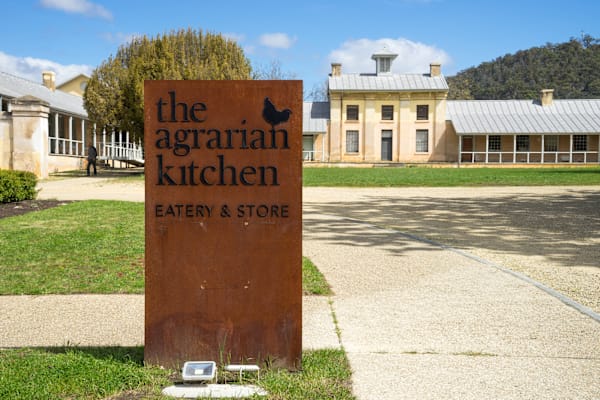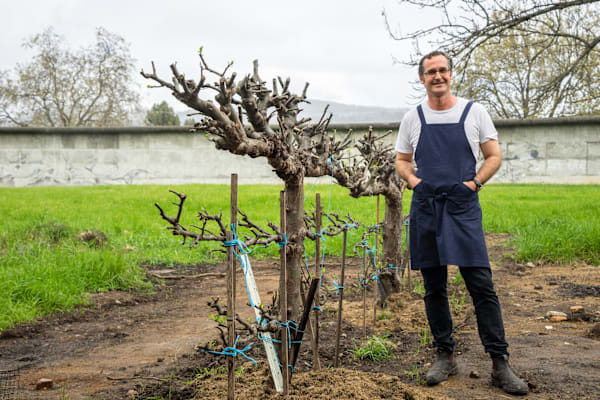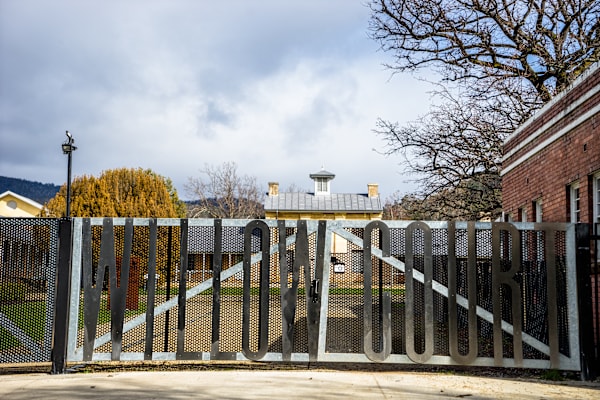As you cross the Lachlan River and wander up Elm Avenue towards the centre of New Norfolk, you might glimpse a honey-coloured light radiating from behind a modern iron fence, a fence artfully warped and twisted, suggesting a barely contained energy within. This is the barracks building, a three-sided sandstone courtyard with a lofty Georgian façade. Built in 1830, it is the oldest remaining part of Willow Court Asylum Complex, Australia’s oldest surviving and longest functioning mental health facility.
The building was designed by renowned colonial architect John Lee Archer, whose Gothic aesthetic shaped some of Tasmania’s best-known buildings. Today, many of the windows are boarded up or broken, and the weeping willows that gave the court its name – planted by Lady Jane Franklin from cuttings taken from Napoleon Bonaparte’s grave – have long since been removed. On a weekday the place is deathly quiet. But if you arrive on a weekend, you are likely to hear the sounds of laughter and children playing echoing off the sandstone walls.
Rodney Dunn and Séverine Demanet, co-owners of the award-winning Agrarian Kitchen Cooking School and Eatery, opened the doors of their restaurant at Willow Court in 2017. They had moved to Tasmania from Sydney in 2007 to run paddock-to-plate cooking classes in nearby Lachlan, but “fell in love” with the Bronte building, a former dormitory ward built c.1925, which stands to the left of the barracks building as you enter the iron gates.

“We’d been running our cooking school for five or six years, and I think we were ready to take on another challenge,” Dunn tells me over a coffee as we watch families gather in the sunshine at his outdoor kiosk, set up for weekend takeaways when the restaurant was forced to close during covid. The kitchen behind us is buzzing, and guests are arriving for their set-menu lunches. Dunn points to the high ceilings lined with original pressed metal which he struggled to preserve throughout the renovations.
Light spills through tall antique windows, framing stunning views of the Derwent Valley below. Jars of preserved fruits glow like jewels on shelves along the walls. “Isn’t it beautiful?” he smiles.
Beauty, however, is in the eye of the beholder. In 2017 a reviewer for The New York Times noted a “stark, almost shocking contrast between Agrarian Kitchen and its surroundings ... The restaurant is smack in the midst of the ruins of [an] asylum, a hulking sprawl of old brick and stone buildings that rise ominously from the side of the road as you enter New Norfolk.”
Yet for Dunn, the complex history and unique architecture of the site is something to cherish rather than shrink away from. “I think it’s all part of the story. I certainly think it adds to the experience. There are very few places on earth that are not stained by the blood of human misery. How do we further ourselves as a culture if [we] don’t try to push the boundaries?”

. . .
Tasmanians have a close and sometimes unsettled relationship with the past. Unlike other parts of Australia, where modern development has erased all but a few traces of colonial or convict heritage, the architectural legacy of our often complicated history remains largely intact. Iconic sandstone buildings run like honeycomb through our urban landscapes, from Battery Point in Hobart to Port Arthur on the Tasman Peninsula, to historic villages like Bothwell, Evandale and Ross. Yet following a decade of recession, Tasmania is now one of the best-performing economies in the country, and with a growing population and rising property prices, there is increasing pressure on local governments to develop historic sites for future use. Given how important these sites are to our collective memory and identity, how do we preserve the past while making way for something new?
This question is particularly poignant here at Willow Court, a place many Tasmanians associate with suffering and trauma. Over its 173-year history, the institution operated under many names, each reflecting changes in social attitudes towards mental illness: Invalid Depot, Lunatic Asylum, Hospital for the Insane, Mental Diseases Hospital, Lachlan Park Hospital, Royal Derwent Hospital and, finally, Willow Court.
In 1847, The Colonial Times reported: “As regards the insane, no attempt is made to cure – the patient is merely imprisoned there, and many, from mental derangement become confirmed maniacs in consequence of the imprisonment and harsh treatment.”
In 1858, a new board of commissioners found conditions at the hospital were “very far behind that of similar institutions in the Mother Country. The internal accommodation of the several buildings were small, badly constructed, ill ventilated, dark, dismal.”
In the 1930s a superintendent discovered a static electricity machine in an attic, along with patient registers from 1851 to 1876 describing its use. One female patient, aged 35, who had lived at the hospital for 20 years, was given “an application of the battery” for refusing to wear shoes or stockings.
Various attempts were made throughout the 20th century to modernise the architecture and implement more enlightened practices, but following international movements towards deinstitutionalisation in the 1990s, patients were gradually released into community care and the hospital effectively closed in November 2000.

. . .
Despite its negative associations, for many former patients, staff, family members and local residents, the site lives on as a powerful symbol of local identity. “Willow Court is part of the fabric of this town,” says Gail Harding, a former resident of New Norfolk, who has seen various proposals for the site celebrated in the media, only to vanish without trace. The Derwent Valley Council took ownership of the site in 2001 and has since invested about $5.5 million in restoration, maintenance and numerous reports investigating future prospects, recognising that “activation of Willow Court is crucial to the ongoing economic development of the town and region”.
For a variety of reasons, however, no long-term vision for the site has been implemented. Many of the 24 buildings across 18 hectares of land have been left to disintegrate, subjected to break-ins, thefts, vandalism, fire damage, graffiti and vermin infestations.
Tarrant Derksen, founder and director of New Norfolk Distillery, says preservation of the site was a key factor in his decision to set up his small business in the industrial therapy building, built about 1973, so that patients could practice various skills and trades. “We are a local family, and whenever I’d come down to visit ... we’d drive past these buildings and saw they were falling into disrepair.” He and his brothers decided the historic site was a fitting place for them to set up the first dedicated rum distillery in Tasmania since Lieutenant Governor John Franklin outlawed the production of “the demon rum” in 1838. “We wanted to bring rum back to the island,” Derksen says as he offers me a sample of his Misty Valley Silver Spirit, named one of Australia's best rums at the 2019 Drink Easy Awards.
Derksen has grand plans to restore and expand into several other buildings at Willow Court, including a micro-distillery, tasting bar, kitchen and event space, and possibly a hotel. When I asked how he intends to balance the old with the new, he points out that the site has been constantly evolving since its foundation. “We want to respect the heritage of the site, so that people can still see what the site was before. What we see ourselves doing here is being the next permutation or the next stage in the site’s history.”

In the absence of long-term investment, Willow Court has provided a temporary stage for events and festivals, such as Dark Mofo in 2016 when Australian performance artist Mike Parr took up residence in the Alonnah Building (formerly the “female maximum security ward for the criminally insane”). For 72 non-stop hours, Parr drew self-portraits in memory of his brother Tim, who suffered from mental illness. The exhibition consisted of various video, sound, photographic and installation works scattered throughout the building. It was extremely popular, and demonstrated the site’s potential as an art gallery, storytelling venue, or studio space.
This potential went one step closer to being realised in 2019, when the council approved a joint proposal from Derwent Valley Arts and Salamanca Arts to turn the barracks building into a community arts centre. Although one wing of the barracks has been renovated, the rest of the building will need a lot of work. There are rotting floors, crumbling ceilings and various other kinds of damage following decades of neglect. But there is hope that the same creative vision that transformed the ordnance stores on the Hobart waterfront into the vibrant tourist hotspot and community hub we now know as Salamanca Place, will breathe new life into these dilapidated buildings.
For Rodney Dunn, the arts and education are key to the future of the Agrarian Kitchen, and Willow Court as a whole. “People tend to think about the arts as something separate from their daily lives,” he says, “[but] people engage in arts [like cooking] every day, and just don’t realise it.”
Over the next two years, Dunn plans to transform the Carlton exercise yard into a kitchen garden that will supply vegetables and fruit for both the restaurant and the cooking school, so that diners can touch and smell the soil where their food was grown. The first plants to go into the ground are two espaliered apple trees. They have been brutally pruned to their stumps but, here and there, green shoots are beginning to bud.
Rayne Allinson is a writer and teacher with a PhD in History from the University of Oxford. She has worked and travelled in many parts of the northern hemisphere, and is now based in southern Tasmania.
Christine Mason is a professional landscape photographer based in southern Tasmania. She is also Rayne Allinson’s mother.







